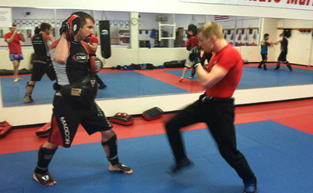Water – Air Bag Continued Experiences
- Published in Blog
- 3 comments
I was recently asked about my experiences with the MaxxMMA Water / Air Heavy Bag, and I would like to share those experiences. We have had the heavy bag for almost 6 months now, and it has become a constant fixture in the gym. The fact that it has a different feel and feedback than the standard “stuffed” heavy bags has made it a dynamic part of our bag work. We regularly run bag circuit classes and cycle through a multitude of bags. We use 2 traditional Thai bags, a Thai knee bag, an uppercut bag, a double end bag, reflex bags and two ground n pound bags. Even with all the bags at our disposal, I have found that the variety of bags, weights and different feedback have added to the challenge and enjoyment of the workouts.
Specifically on the Water / Air Bag, we have found that impact and the absorption of force is enough to cause a different level of concentration and effort. Even though we work the same punching, elbows, knees and kicks; the workout rounds feel different. It effects the timing of strikes, the footwork involved and how much effort is spent. I also feel the initial impact on the bag is more forgiving, and firms up as you penetrate the surface. I feel I can really lay into the bag and risk less chance of injury. I also feel the bag has a bit less sway than a comparable stuffed bag. I look forward to seeing how the MaxxMMA line contributes to the development and conditioning of our athletes.
About the author
Ray White's Midwest Martial Arts teaches Muay Thai and Mixed Martial Arts to students, amateur and professional fighters from Minnesota, Wisconsin and Michigan. He can be reached at the SMB Academy in Battle Creek Michigan, at www.facebook.com/RayWhiteMMA and at www.mmacoachescorner.com .



